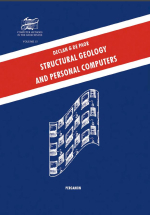Добрый день, Коллеги. Важное сообщение, просьба принять участие. Музей Ферсмана ищет помощь для реставрационных работ в помещении. Подробности по ссылке
Structural geology and personal computers / Структурная геология и персональный компьютер
Some thirty years ago, structural geology underwent a revolution that fundamentally changed how we think about the deformation of rocks. Regional field observations and laboratory data were given profound new meaning in terms of the global model of lithospheric behavior called "Plate Tectonics". Today structural geologists are witnessing a second revolution and although it is of a very different, less fundamental, type it will clearly have a profound and lasting effect on our field. This new revolution has been fuelled by the widespread use of the personal computer which has become the principal tool of scientists worldwide for data storage or retrieval, teaching, communication with colleagues, number crunching, modeling, and preparation of publications.
The current exponential growth in the power of personal computers is radically changing how we work and how we study. Calculations that were intractable only a few years ago are now within the capabilities of geologists with only basic math skills. Data that would have taken months or years to gather from various sources are retrievable in an instant by electronic means. Fabrics and textures that were previously described only qualitatively can now be quantified with the aid of novel mathematical devices such as fractals (which themselves resulted from the effects of the personal computer revolution on the field of mathematics). Interpretations can be more rigorously tested and results more meaningfully and forcefully presented.
The radical change in work practices brought on by the personal computer revolution is redirecting our research efforts. Computers will ultimately influence what research problems we decide to tackle and how we think about geological structures. Hopefully, the results will include both a higher standard of research work, as new insights are obtained through new means of visualization, and also a greater democratization of research and education, as the wisdom of scientists working in the world's best-endowed universities is transmitted to the desktops of brilliant students who are unfortunate enough to be located in the world's most disadvantaged regions.
This volume presents just some of the new directions and new possibilities that personal computers are opening up for structural geologists. An attempt was made to include material of interest to a wide range of geologists, not just those who already know a great deal about computers. In addition to articles involving sophisticated modelling programs such as AutoCAD™ or C** compilers, there are articles for those whose programming skills are limited to HyperCard™ or who still use DOS™. The aim is to present a view of the current state of personal computer use throughout structural geology, not just the "leading edge". Initially, a two-part book was planned, with part 1 written by the editor and part 2 by the contributing authors. However, the range of subjects submitted was such that it seemed more appropriate to distribute the editor's contributions through the book; hence the unusually large number of such contributions!
Camera-ready copy for this book was prepared by the editor on a Power Macintosh 9500/132 running System 7.5.2 with 16 MB RAM and a 2GB hard drive. Authors were given a choice of English or American usage. Text and images were submitted by contributors either by e-mail, on diskette, or on paper. The latter were scanned using Read-It™ optical character recognition and Photoshop™ 3.0 image access software on a LaCie Silverscanner III. Output was printed at a resolution of 600 dpi on 241b. high-gloss bond with an Apple LaserWriter 4/600 PS laser printer and an Apple Color StyleWriter 2400 inkjet printer. Page proofs were prepared using Nisus™ 4.0 for word processor, Pagemaker™ 6.0 for page layout, Canvas™ 3.5 for drawing, and Expressionist™ 2.0 for mathematical typesetting. Some graphics were incorporated from hard copy by camera. Interestingly, no products manufactured by Microsoft Inc. were required! The principal fonts used were New Century Schoolbook and Times for the main text, Symbol for mathematical expressions, and Courier for computer code and command words. Names of items of computer hardware are capitalized; software product names are set in italics. All trademarks are the property of their respective owners.
The editor now understands why authors and editors commonly thank their spouses for not divorcing them during book preparation. In addition to lending moral support, Carol Simpson did more than her share of reviewing and proof-reading. I am grateful to her and to all the contributors and reviewers who made this publication possible. As a condition for consideration of their own manuscripts, all contributing authors agreed to serve as reviewers and most carried out this commitment punctually. In addition, I am very grateful to Bob Burger, Mike Ellis, Eric Erslev, Dave Gray, Laura Goodwin, Mary Beth Gray, Renee Panozzo Heilbronner, Rick Law, Stephen Marshak, Ken McCaffrey, Win Means, Dan Merriam, Katsuyoshi Michibayashi, Brendan Murphy, Paul Ryan, Dave Sanderson, and Robert Twiss, some of whom reviewed more than one manuscript. Julie Bartley compiled the subject index. Thanks are also due to Peter Henn of Elsevier Science Ltd. for his encouragement and patience. Grant support from the National Science Foundation (EAR-9304879) is gratefully acknowledged.




